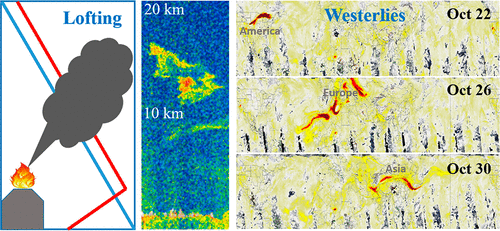当前位置:
X-MOL 学术
›
ACS Earth Space Chem.
›
论文详情
Our official English website, www.x-mol.net, welcomes your
feedback! (Note: you will need to create a separate account there.)
Lofting and Circumnavigation of Biomass Burning Aerosols and Carbon Monoxide from a North American Wildfire in October 2020
ACS Earth and Space Chemistry ( IF 2.9 ) Pub Date : 2021-02-05 , DOI: 10.1021/acsearthspacechem.0c00307 Changqing Lin 1 , Yinghua Zhang 2
ACS Earth and Space Chemistry ( IF 2.9 ) Pub Date : 2021-02-05 , DOI: 10.1021/acsearthspacechem.0c00307 Changqing Lin 1 , Yinghua Zhang 2
Affiliation

|
Hemispheric transport events of air pollutants from North American wildfires are not common. On 22 October 2020, the exceptionally intense East Troublesome Fire in the Rocky Mountains injected a huge mass of air pollutant mixtures including biomass burning aerosols and carbon monoxide into the atmosphere. In this study, we used atmospheric sounding to explore atmospheric stability and lofting of the pollutant mixtures. We then took advantage of multisatellite measurements (e.g., reflectance data from Moderate Resolution Imaging Spectroradiometer (MODIS), ultraviolet aerosol index from Ozone Mapping Profiler Suite (OMPS), carbon monoxide concentration from Atmospheric Infrared Sounder (AIRS), and atmospheric vertical structure from Cloud-Aerosol Lidar and Infrared Pathfinder Satellite Observation (CALIPSO)) to track the three-dimensional long-range transport of pollutant mixtures. Near the pollution source, a deep neutral layer lay above a stable temperature inversion layer. The heated plume released in the neutral layer resulted in a lofting of the pollutant mixtures into the westerly jet stream in the upper troposphere, with an injection height ranging from 8 to 13 km. The pollutant mixtures were then transported eastwards by the westerly winds in the upper troposphere and lower stratosphere during different periods of its evolution. The pollutant mixtures arrived in the upper air over East Asia after 8 days of transport from the source. A part of the smoke circumnavigated the globe and returned to the upper air over North America after 14 days. These results indicate that hemispheric transport of the combustion products from wildfires occurs when atmospheric stability favors the lofting of air pollutants into a jet stream in the upper troposphere.
中文翻译:

2020年10月北美野火燃烧的生物质燃烧气溶胶和一氧化碳的放行和绕行
来自北美野火的空气污染物的半球运输事件并不常见。2020年10月22日,落基山地区异常强烈的东非大火将大量的空气污染物混合物注入大气,其中包括燃烧生物质的气溶胶和一氧化碳。在这项研究中,我们使用大气探测来探索大气稳定性和污染物混合物的放空。然后,我们利用了多卫星测量的优势(例如,中分辨率成像光谱仪(MODIS)的反射率数据,臭氧测绘仪套件(OMPS)的紫外线气溶胶指数,大气红外测深仪(AIRS)的一氧化碳浓度,气溶胶激光雷达和红外探路卫星观测(CALIPSO)的大气垂直结构,以跟踪污染物混合物的三维远距离传输。在污染源附近,一个深的中性层位于稳定的温度反转层之上。在中性层中释放的加热的羽流导致污染物混合物在对流层高层向高空西风急流中扩散,注入高度为8至13 km。然后,污染物混合物在其演变的不同时期被对流层上层和平流层下层的西风向东输送。从源头运输了八天后,污染物混合物到达了东亚上空。14天后,一部分烟雾绕地球飞行,并返回北美上空。这些结果表明,当大气稳定性有利于将空气污染物向对流层上方喷射流时,会产生野火燃烧产物的半球运输。
更新日期:2021-02-18
中文翻译:

2020年10月北美野火燃烧的生物质燃烧气溶胶和一氧化碳的放行和绕行
来自北美野火的空气污染物的半球运输事件并不常见。2020年10月22日,落基山地区异常强烈的东非大火将大量的空气污染物混合物注入大气,其中包括燃烧生物质的气溶胶和一氧化碳。在这项研究中,我们使用大气探测来探索大气稳定性和污染物混合物的放空。然后,我们利用了多卫星测量的优势(例如,中分辨率成像光谱仪(MODIS)的反射率数据,臭氧测绘仪套件(OMPS)的紫外线气溶胶指数,大气红外测深仪(AIRS)的一氧化碳浓度,气溶胶激光雷达和红外探路卫星观测(CALIPSO)的大气垂直结构,以跟踪污染物混合物的三维远距离传输。在污染源附近,一个深的中性层位于稳定的温度反转层之上。在中性层中释放的加热的羽流导致污染物混合物在对流层高层向高空西风急流中扩散,注入高度为8至13 km。然后,污染物混合物在其演变的不同时期被对流层上层和平流层下层的西风向东输送。从源头运输了八天后,污染物混合物到达了东亚上空。14天后,一部分烟雾绕地球飞行,并返回北美上空。这些结果表明,当大气稳定性有利于将空气污染物向对流层上方喷射流时,会产生野火燃烧产物的半球运输。









































 京公网安备 11010802027423号
京公网安备 11010802027423号